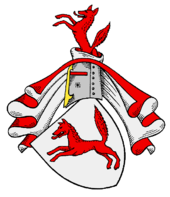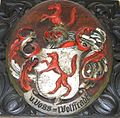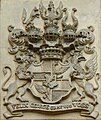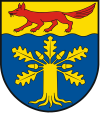Voss (Mecklenburg noble family)
Voss ( more rarely: Voss, Latin: Vulpes) is the name of an old noble family from Mecklenburg , which belonged to the primeval nobility of the country and was first mentioned in a document on May 15, 1253 with Johannes Vulpes, councilor of Prince Nikolaus I. von Werle . The family owned goods mainly in Mecklenburg and Prussia.
Lines
Family genealogy distinguishes houses
- Sarov (line extinguished in the 16th century)
- Book (Prussian count 1840)
- Gievitz (Prussian count 1800)
- Luckow (Danish nobility naturalization 1777)
- Lüssow , near Gützkow, Western Pomerania
- Dölzig , (pol. Dolsk (Dębno) ) near Soldin
history
In 1292 Prince Nikolaus von Werle enfeoffed the loyal knight Heinrich Voss for services rendered with the villages of Luplow and Rosenow for permanent possession. The estate in Luplow remained in the possession of the von Voss family without interruption until it was expropriated in 1945. The oldest feudal deed of the Voss from Gievitz dates from 1332, in Rumpshagen the Voss have been documented since 1310. From 1356 to 1516 the family was also based in Sarow (with Ganschendorf).
Gut Luplow , owned by the family from 1292 to 1945, the manor house built around 1730
Gut Groß Gievitz , owned by the family from 1332 (with interruption) to 1929
Gut Rumpshagen , owned by the family from 1310 to 1752, the manor house built from 1730
In the 16th century, the Gievitz estates came to the Flotow at Stuer Castle and the Hahn at Basedow Castle , in 1616 the Voss were able to regain ownership, but the Gievitz estate was again bankrupt when Carl von Voss died in 1641. His brother Jürgen von Voss († 1669) was married to Elisabeth von Oertzen and he managed to redeem the pledged property. He left five sons, from whom Ernst Christoph von Voss (1655-1720) received the Gievitz property, but by comparison in 1673 and 1675 he came to his brother Jürgen Ulrich von Voss and his wife Anna von Bülow , who in 1684 transferred the property to the von Pledged Erlencamp . Ernst Christoph was in the service of Brunswick-Lüneburg and later of Hanover. By marrying Anna Magdalena von Witzendorff , a patrician daughter from Lüneburg , he succeeded in consolidating his economic situation and in 1693 in getting the Gievitz estate back for a large payment. He died childless. His heir was his nephew Friedrich Ernst von Voss (1700–1738), who had the baroque manor house Rumpshagen built in 1730–32, but who soon died young and left two underage sons. Friedrich Christoph Hieronymus von Voss (1724–1784) received the goods in Flotow and Klein Helle and later acquired properties in Prussia, where the book line developed.

Johann Ernst von Voss (1726–1793) received the goods in Gievitz, Schönau and Rumpshagen, which he however sold to Justus von Gundlach in 1752 . Johann Ernst was a diplomat at the Prussian royal court, district president of Magdeburg and chief steward of Queen Elisabeth Christine , wife of Friedrich II. His wife Sophie Marie von Pannwitz (1729–1814) was first maid of honor of the queen mother Sophie Dorothea and came after the death of Johann Ernst as chief stewardess for Crown Princess Luise back to the Prussian court. She lived at the Prussian court for sixty-nine years and was a discussion partner and advisor to queens and kings and educator of the children for decades. In 1800 she was awarded the ribbon of the Black Eagle Order and raised to the status of hereditary count. Her niece Julie von Voss became the morganatic wife of Friedrich Wilhelm II in 1787 .

Her grandson August Ernst von Voss (1779–1832) married Luise von Berg (1780–1865), a daughter of Caroline von Berg, who was also a close confidante and biographer of Queen Luise. August Ernst von Voss had a funeral chapel built for his mother-in-law in Groß Gievitz from 1827 to 1831. His son Felix Georg von Voss (1801–1881) married Louise Wilhelmine von Hahn († 1833) in 1826 and became a fiefdom holder in Schorssow the following year . From 1835 he managed the Gievitz estate himself and from 1841 was married to Luise Henckel von Donnersmarck (1820–1902), who became the foster mother of Odo Deodatus I. Tauern in old age . The renovation of the village after a fire in 1820 goes back to Felix von Voss, the renovation of the village church Groß Gievitz in 1857 to his mother Luise von Berg. Felix's son Eugen Georg von Voss (1827–1890) was an Austrian treasurer and captain, married Erzsebet Szapary de Muraszombath in 1852 and, like his father, received Schorssow and Carlsdorf as a fief. The last member of the Gievitz line was Felix von Voss (1856-1931), who came to Gievitz in 1892 with his wife Esther Lawrence (1872-1976). The couple remained childless and sold the estate in 1929.
In Einschreibebuch the monastery Dobbertin are 15 items of daughters of the family of Voss 1702-1900 from Schwandt, Luplow, Ganzkow and Lüssow for inclusion in the aristocratic convent in the monastery Dobbertin .
The Lüssow line was created in 1841, when the Lüssow estate came to his cousin Achim von Voss after the childless death of Hermann von Wolfradt , who has called himself von Voß-Wolfradt since then and built Lüssow Castle in its current form. The property also included goods in Consages, Klein Polzin, Owstin and Pentin. The Voss-Wolfradt did not manage the goods themselves, but leased them. In 1911 Vicco von Voss-Wolfradt owned the goods. In the 1920s the family went bankrupt and some estates were sold and relocated. Vicco von Voss-Wolfradt shot his wife Elisabeth von Pfeil and Klein-Ellguth, his daughter and a grandchild, the estate secretary and himself on April 30, 1945 in the forest near Lüssow; they were secretly buried there on the spot by villagers.
The relatively young line Voss- Dölzig is a subsidiary line of the Voss-Buch branch. The first representative was Georg Anton Graf von Voss-Buch, Knight of Honor of the Order of St. John , who in 1891 acquired the Dölzig manor from the widow of Tassilo von Tresckow and in 1892 became Fideikommissherr in Dölzig. He died in 1904, and the Fideikommiss and Majorat Dölzig went to his brother, Max Wilhelm Karl Ferdinand von Voss, who has also called himself Voss-Dölzig since then. From the marriage of Max Wilhelm with Luise v. Block have 2 daughters and a son, Karl-Achim v. Voss-Dölzig. The latter died unmarried and childless on May 1, 1945 in Berlin . The Voss-Dölzig line was thus extinguished.
coat of arms
The family coat of arms shows a jumping red fox in silver. The fox growing on the helmet with red and silver covers. → s. O.
Alliance coat of arms of those von Witzendorff-Voss 1707 in the village church Groß Gievitz
The coat of arms of the Counts von Voss Buch burial place at the Schlosskirche Buch near Berlin
Coat of arms of the place Groß Gievitz (derivative of the family coat of arms)
Known family members

- Samuel von Voss (1621–1674), German Lutheran theologian
- Friedrich Christoph Hieronymus von Voss (1724–1784) was the Prussian ambassador to the Danish court in Copenhagen and Warsaw, chief steward, secret counselor and provost of the monastery at Havelberg
- Johann Ernst von Voss (1726–1793) was the district president of Magdeburg and court marshal of the Prussian queen
- Sophie Marie Countess von Voss , b. von Pannwitz (1729–1814), lived at the Prussian court for 69 years
- Otto Carl Friedrich von Voss (1755–1823), secret minister of state and cathedral dean in the Kingdom of Prussia
- Julie Amalie Elisabeth von Voss, Countess von Ingenheim (1766–1789), was court lady and later wife of the Prussian King Friedrich Wilhelm II.
- Julius von Voss (1768-1832) was a German writer
- Wilhelm von Voss (1784–1818), Prussian district administrator
- Karl Graf von Voss-Buch (1786–1864), Prussian secret councilor, member of the State Council since 1835
- Ferdinand von Voss-Buch (1788–1871), Prussian general of the infantry
- Achim von Voß-Wolffradt (1837–1904), Prussian manor owner and politician, MdH
- Viktor Graf Voss (1868–1936) tennis player and three-time German champion from 1894–1896
See also
literature
- W. Bollmann: Gross Gievitz and the von Voss family. In: Series of publications by the Waren Museum and History Association. Waren (Müritz) 1996, no.9.
- Friedrich Crull : The coats of arms of the genders of the team that existed in today's Meklenburg boundaries until 1360. In: Yearbooks of the Association for Mecklenburg History and Archeology. Volume 52, 1887. pp. 92-93 ( Memento from May 5, 2012 in the Internet Archive ) and Siegel png
- Genealogical manual of the nobility , Adelslexikon . Vol. 15. Vol. 134 of the complete series. Pp. 316-318, Limburg / Lahn CA Starke Verlag 2004. ISSN 0435-2408
- Gothaisches Genealogisches Taschenbuch der Graefliche Häuser , Justus Perthes , Gotha 1846, p. 670 ; 1874, p. 921 ; 1876 p. 959 f.
- Otto Titan von Hefner : Register of the thriving and dead nobility in Germany. Volume 4. G. J. Manz, Regensburg 1866, p. 138
- Ernst Heinrich Kneschke : New general German nobility lexicon . Volume 4, Leipzig, Friedrich Voigt 1863, pp. 579-580 ; Volume 9, 1870, pp. 419-421.
- Gustav von Lehsten: The nobility of Mecklenburg since the constitutional hereditary comparisons (1755). J. G. Tiedemann, Rostock 1864, pp. 277-278 .
- Georg Christian Friedrich Lisch : The oldest seals of the noble family Voss. In: Yearbooks of the Association for Mecklenburg History and Archeology. Volume 33, pp. 200-204
- E. Vehse : The Counts Voss. In: History of the German courts since the Reformation. Volume 36, Sixth Section: The Small German Courts. Second part. Hamburg, Hoffmann and Campe 1856. pp. 173-181 .
- F. and S. Voss: History of the families of Voss from Mecklenburg-Western Pomerania, Pomerania, Denmark. In: Materials on Family History, No. 4, Bonn. Berlin 2000.
- Leopold von Zedlitz-Neukirch : New Prussian Adelslexicon . Volume 4. Gebr. Reichenbach, Leipzig 1837, pp. 301-302 .
Web links
- Literature about families (from) Voss in the state bibliography MV
- Groß Gievitz line on lexikus.de
- Gut Groß Gievitz
- Gene wiki: Voss (family name)> heraldry, heraldry> Voss, von Voss, (Pomerania, northeast Germany)
Individual evidence
- ↑ Mecklenburg record book No. 721
- ↑ Peter Heinke, Jürgen Luttmann: The coats of arms in the churches and mansions Kittendorf, Luplow, Schwandt and Bredenfelde. 2008, pp. 34-39.
- ↑ Since December 23, 1800 married to August Ernst Graf von Voß (1779–1832), a grandson of the Oberhofmeisterin Sophie Marie Countess von Voss . She wrote a "house book" for the family v. Voss on Gr.-Gievitz.
- ↑ Genealogical Handbook of the Nobility , Graefliche Häuser A, Volume VIII, p. 443
- ↑ Contains gender with the same name, pp. 315–321: de Vos, Voss (Diepholz), Voß (Oldenburg), Voß (Westphalia), Voß (1786), Voss (1842), Voss (1865) and Voss (1882).











